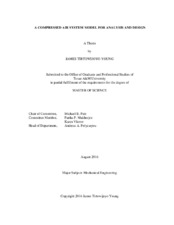| dc.description.abstract | The typical efficiency of a compressed air system ranges from 5% to 20%, making it one of the most expensive utilities in industrial plants, hence its name, “the fourth utility”. It is certain that compressed air is an inefficient way to power any industrial machine; however with the large number of compressed air tools being used in factories or manufacturing facilities, it is uneconomical and impractical to replace all of the industrial tools with electric powered ones. In spite of its inefficiency, compressed air has many advantages that make it attractive and essential for industries. Some of the advantages of compressed air are that it can be easily stored and transported, tools are lightweight, cheap, and maintenance-free, and compressed air works well with different air temperatures, pressures and flow speeds. Finally, compressed air tools are spark-free, and high-torque.
Because the compressed air system is the largest consumer of electricity in industry, it is important to optimize the compressed air system and all of its components, to make sure that the system runs as energy efficient as possible. Moreover, a careful calculation of how each of the components works together as a single system is necessary to determine the system’s performance, unnoticeable problems, and suitable energy improvements.
The main objective of this research is to model and calculate the compressed air system performance that includes determining the temperatures, pressures, flow rates, and leakages at each point in the system. Of special importance, the compressed air system model using MATLAB will output the work and heat transfer rates mainly for the air compressor and the cooling system. The model is meant to be able to calculate several different unknown variables that are related to each of the components, depending on what values are known. Once the model and program are developed, they can be used to perform design and analysis for several different single compressed air systems. This design and analysis effort will allow an engineer to determine the energy consumption of components and output parameters, and to investigate possible changes to improve the system efficiencies. | en |


